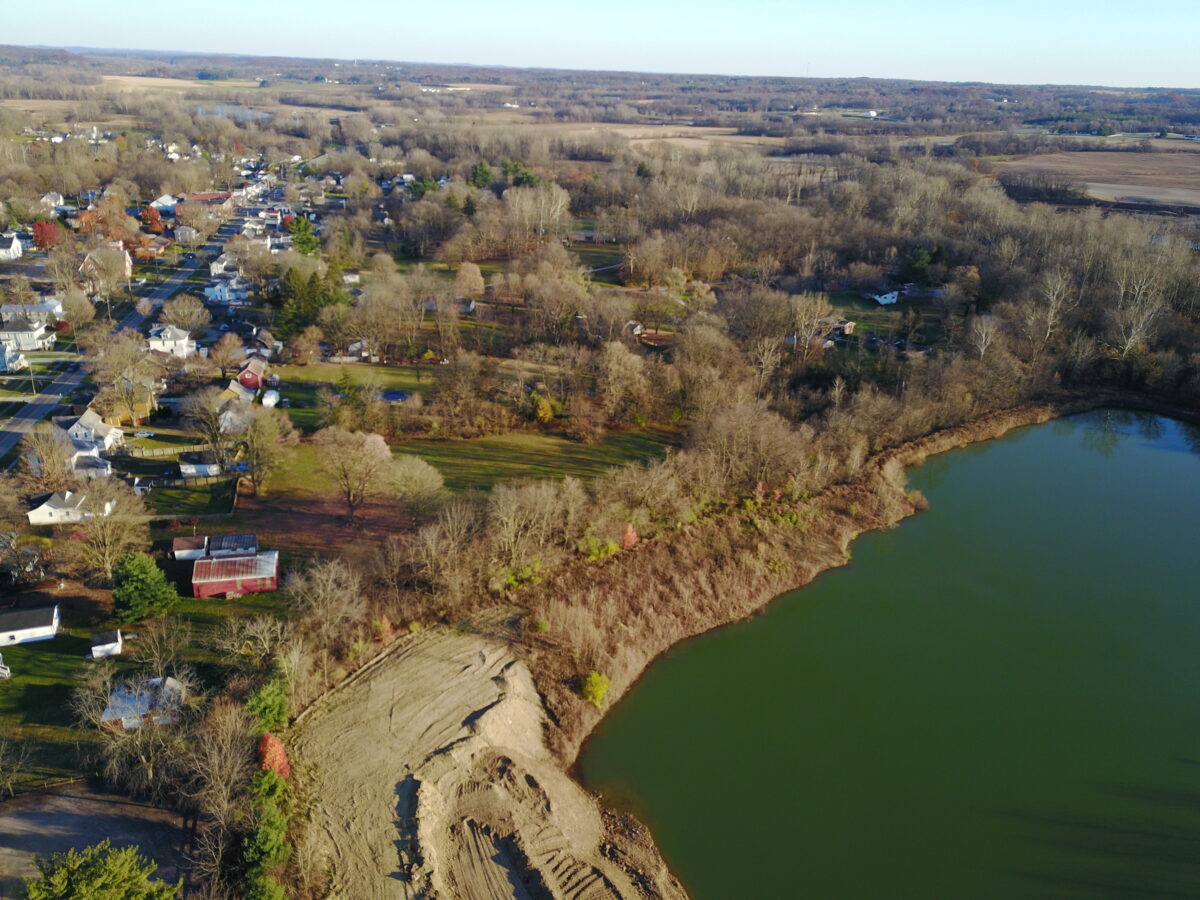A search for additional water sources for Intel that came to light when a Granville Township trustee sold 106 acres to The New Albany Company in September has been going on two years longer and is more extensive than some officials in Licking County knew.
And Granville officials are raising alarms about possible drinking water contamination from a federal Superfund site in the village if anyone disturbs the aquifer serving Granville and Alexandria residents by drilling new wells nearby and pumping significant amounts of water from the aquifer.
At the same time, local officials from across western Licking County say the county commissioners need to provide more leadership so that government leaders at all levels are working together rather than leaving each community to fend for itself as development accelerates.
Initial exploration for water
Construction of Intel’s first factories near the intersection of Mink Street and Green Chapel Road in western Licking County has been underway for months, with the goal of producing computer chips beginning in 2025. The City of Columbus has promised to provide the 1.5 million gallons of water per day that Intel needs for its manufacturing process.
If Intel expands beyond the first phase, as the company has indicated it plans to do, it could need millions of gallons of additional water, and that water has to come from somewhere, said Jennifer Chrysler, director of community development for the City of New Albany.
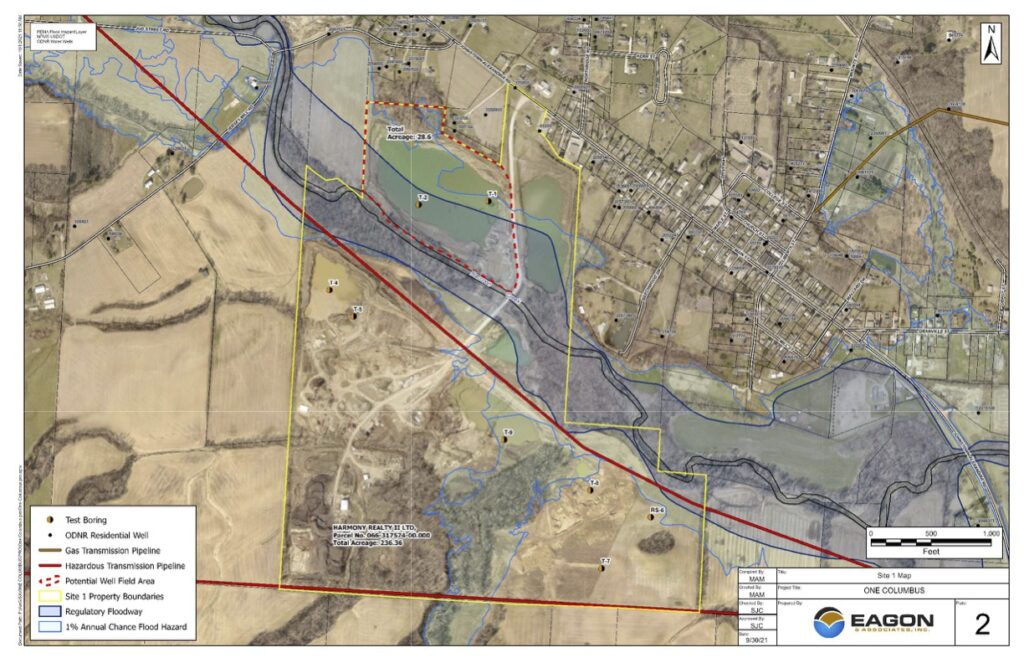
The search for additional water sources began as early as 2021, according to a report from EMH&T, a Columbus civil engineering firm commissioned by the economic development organization One Columbus.
In the report, provided to The Reporting Project by the City of New Albany, EMH&T identified a potential water source near the Village of Alexandria, and includes a preliminary study dated Oct. 1, 2021, by the Columbus-based hydrology consulting firm Eagon & Associates. That study shows 10 possible water sources, ranging from about 5 miles to nearly 40 miles from the Intel site.
The EMH&T report, dated Oct. 28, 2021 – about the time that rumors began circulating about Intel coming to Licking County and two months before the Intel project was announced – is focused on property near Alexandria described as “Area 1” and “Site 1.”
The site, which straddles Raccoon Creek just south of Alexandria in St. Albans Township, is about 28 acres within a 236-acre property owned by Harmony Realty II Limited, which is home to Brookside Materials Sand & Gravel and Kurtz Brothers Top Soil & Mulch. The creek flows southeast from there, and provides water that recharges the aquifer from which Granville pulls its drinking water.
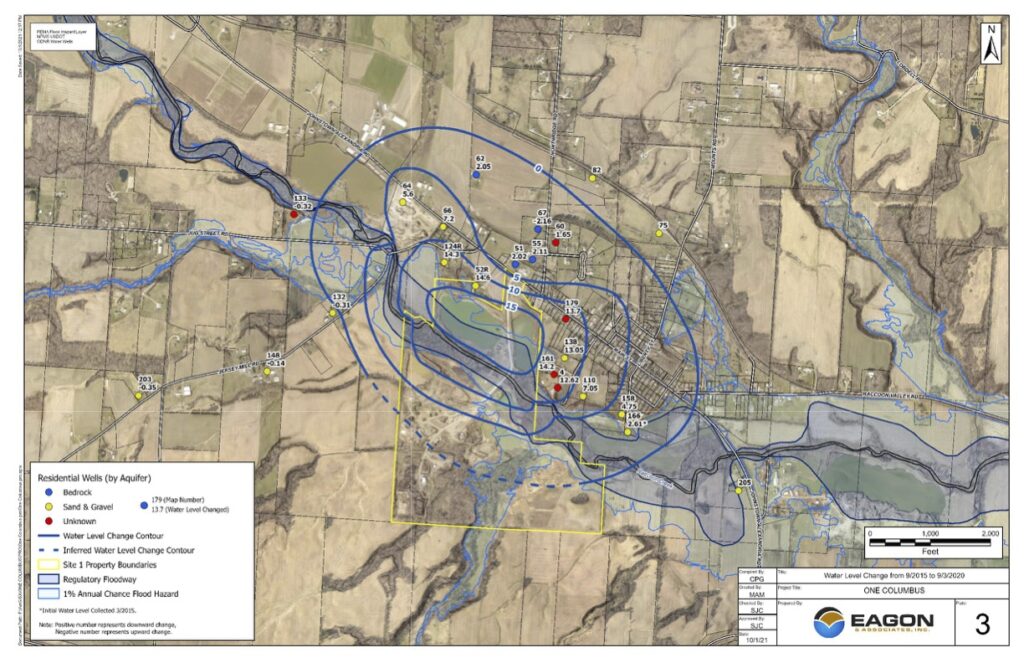
The October 2021 EMH&T report to One Columbus said testing was underway at the site, which could “have the potential to produce a capacity of approximately … 4.5 MGD (million gallons per day).”
However, it said that withdrawal beyond 3 million gallons per day could result in residential wells and ponds in the Alexandria area running dry. But even so, the memo said, the site “has the best potential for water supply development.”
The Oct. 1, 2021, Eagon memo said it expanded upon a Sept. 17, 2021, memo to EMH&T, which Chrysler said New Albany does not have in its files.
“Site 1 is an active sand and gravel extraction operation,” the Oct. 1 memo said, and that continuously removing water to allow for mining from 2016 to 2021 affected “21 residential wells and five surface ponds.” Restoring water to those residences involved drilling deeper wells or connecting residents to the Granville water supply that serves most of Alexandria, the memo said.
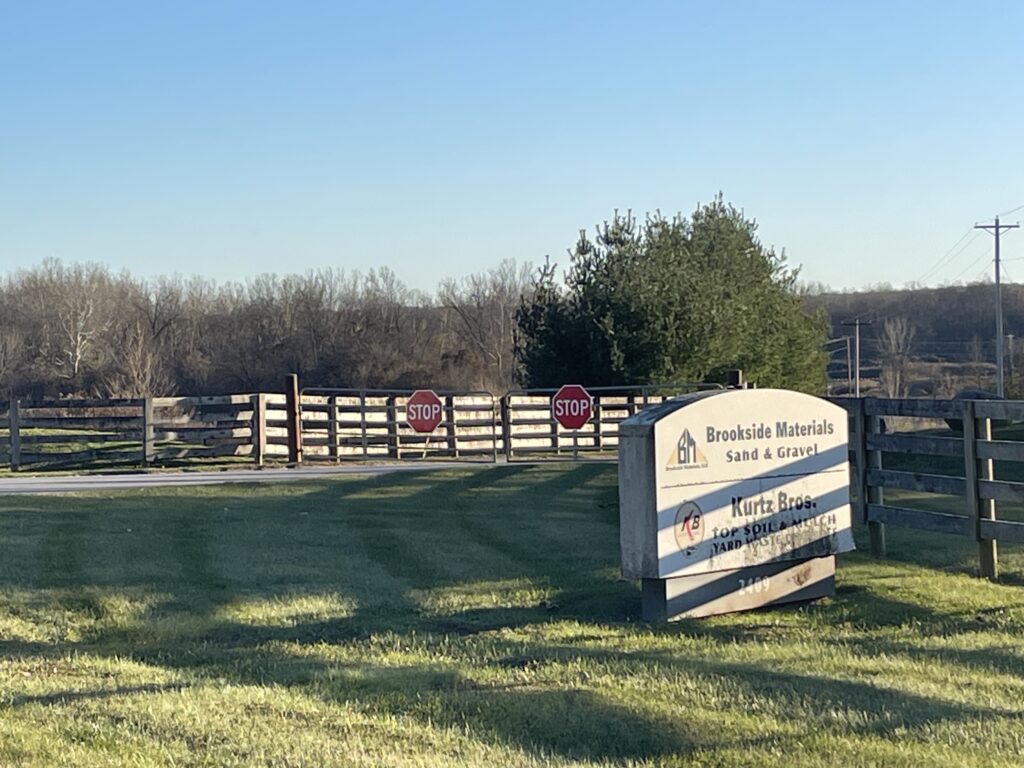
It also notes that taking water from that site and meeting EPA standards for “potable wells,” which means safe for drinking water, “would be difficult.” But developing wells for non-potable water, which could be used for industrial purposes, faces less regulation, EMH&T said in its memo.
Eagon & Associates said at the time that more investigation and testing would be needed at the site, but “based on our current knowledge of the site from test borings, the water withdrawal history from the quarry and resulting drawdown and recovery, if suitable aquifer materials are present at potential well sites, we estimate that an eventual capacity of approximately 4.5 MGD can be developed at Site 1.”
Contamination concerns
The new concern in Granville is focused on a plume of toxic chemicals from a defunct solvents company that has been stationary in the aquifer under Granville for decades.
Granville Village Manager Herb Koehler said that an engineering firm monitoring the plume on behalf of the federal Environmental Protection Agency said that any future wells west of the village drawing millions of gallons of water a day could pull that toxic plume into the village’s well field and pollute drinking water for Granville and Alexandria, which buys water from Granville.
“They are concerned about the impact to that plume if industrial levels of water are removed from our aquifer,” Koehler said. “The plume is stable. It is monitored, but any disruption of this volume and magnitude is a concern.”
The former Granville Solvents company, which operated along the bike path under the Cherry Street bridge from 1958 until 1986, stored specialty fuels and chemicals used in the printing and dry-cleaning businesses in underground tanks and above-ground barrels, The Advocate reported in 2020. The company closed in the late 1980s, and an inspection in 1990 revealed that some of the tanks and drums had leaked, causing high levels of contamination in the soil and groundwater.
It was declared an EPA Superfund site, and it took nearly 15 years to clean up the site, however the toxic plume remains stationary below the surface.
Koehler said that if New Albany drills test wells on the 106 acres it bought from Granville Township Trustee Dan VanNess in September, just west of the village’s well field, Granville will hold the city of New Albany to its promise to share what it learns.
“If they are only looking at volume of water and how much can be pumped, and how much it would draw down the water table, they’re not looking at the plume or our comprehensive plan for the future of our community,” Koehler said.
Lack of inclusion
Koehler and Jim Lenner, St. Albans Township administrator and president of Neighborhood Strategies, a strategic community planning firm, both expressed concern about a lack of communication by New Albany Company and New Albany city officials with officials in communities where New Albany is looking at potential water sources.
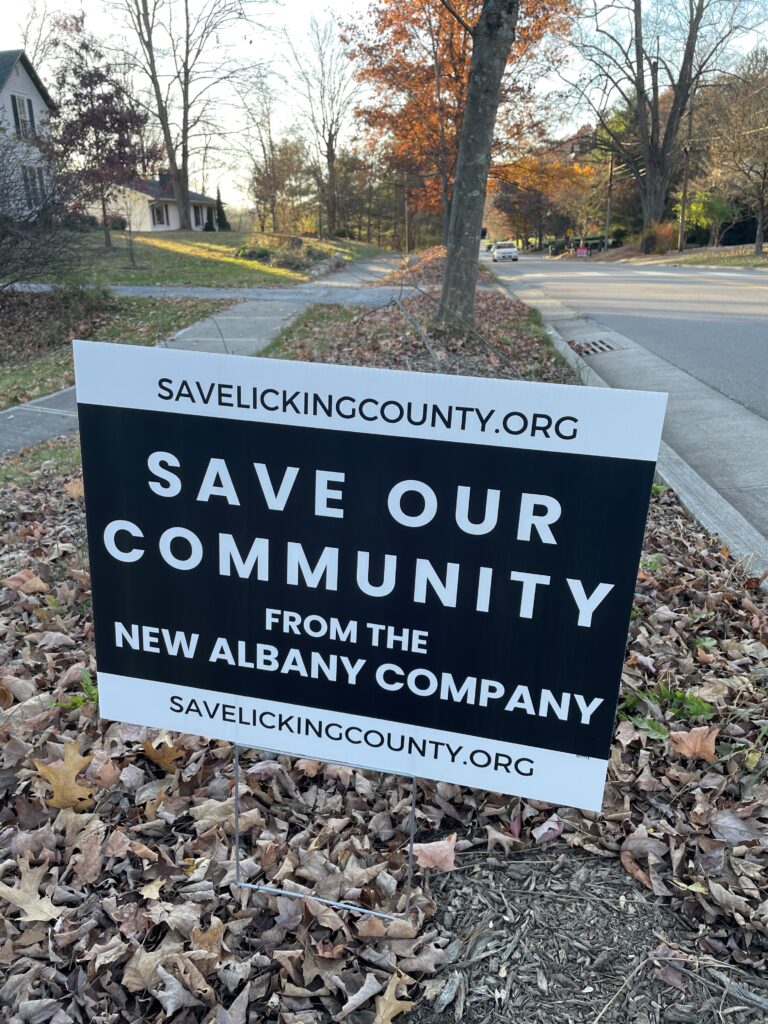
“No one has talked with us,” Lenner said about officials in St. Albans Township, which is home to the Village of Alexandria and just west of Granville Township. “For one community to come into another community and exploit resources for their own self-interest is very disheartening. Sometime, very quickly, that needs to stop.”
Koehler said he and officials from Johnstown met recently with officials from the Ohio Development Department and New Albany, and, while the tone was cordial, he said, not much was accomplished. “I appreciate that they reached out, but the fact is, they only reached out because they were getting bad press.”
“I heard them say that they’d take the water they need and give us the scraps,” Koehler said. “They did commit to sharing, but it’s clear that their mission is to serve the interests of Intel and not the long-term needs of the local community.”
Koehler said he asked the City of New Albany to consider what’s best for the Licking County community in the future, and for New Albany to base decisions on water needs in Granville not only for 2023, but also decades into the future.
Chrysler, the New Albany director of community development, said that any future development of water sources for use by Intel in New Albany would be done in partnership with a utility that could deliver the water to the city, and that the process would be regulated in some fashion.
Those partners could include Del-Co Water Company, Johnstown, Newark, and Southwest Licking Community Water and Sewer District, Chrysler said.
“This idea that somebody is going to come in and put a pump in – an unregulated body, whether private or public – is going to come in and install a pump and just start siphoning water to another part of the county is false – that’s not allowed by law,” she said.
Josh Poland, New Albany’s chief communications and marketing director, said, “We want to be good partners out there. So with our testing, if reports come back that it’s going to have a negative impact on surrounding water supplies, we don’t want to move forward with that.”
“Or partnering with someone who would think that’s OK,” Chrysler added.
She said that New Albany has been tasked by the state to identify water sources and obtain information about the volume and quality of water available from those sources. “These studies take six to nine months. They’re very expensive,” she said, noting that they can cost several hundred thousand dollars per test site.
While it is expensive, Chrysler said, New Albany can afford it because the city received state grant funding for that purpose and has budgeted $1.5 million to perform the due diligence the state and city promised in the development package that helped Intel decide to build its $20 billion factory complex on about 1,000 acres in western Licking County.
She said New Albany will share with the public what it learns from testing at various possible water-resource sites.
The Mid-Ohio Regional Planning Commission (MORPC) is working with the Ohio Environmental Protection Agency and the Ohio Department of Natural Resources to develop a water-supply plan for a 15-county area of central Ohio, where significant growth is anticipated in the coming years. The goal is to complete the study in Delaware, Fairfield, Fayette, Franklin, Hocking, Knox, Licking, Logan, Madison, Marion, Morrow, Perry, Pickaway, Ross and Union counties by the end of 2024.
“Water is our region’s currency, so to speak,” said Kerstin Carr, MORPC’s chief regional strategy director and senior director of planning, adding that the organization is meeting with officials in the area and wants to hold a larger meeting of local officials to discuss water supplies and wastewater treatment.
Frustration continues
Granville Village Manager Koehler was incredulous after recently receiving the two-year-old memo from New Albany.
“If there’s no plan, how is it that One Columbus, along with the state and New Albany knew this and didn’t share it with the people it would affect the most until now?” Koehler asked.
Chrysler said New Albany officials assumed that Licking County officials were sharing information with local officials.
County Commissioner Tim Bubb said the commissioners didn’t have a lot of information to share, and that with the New Albany Company, “you sometimes feel like you’re on a need-to-know basis, and they’re a private company, so they aren’t obligated to tell us everything they’re thinking.”
Communication is improving, Bubb said, noting that the City of New Albany has been working to connect with Licking County’s local officials. He said the commissioners probably could do more to bring community leaders together, and that a recently completed, county-funded study of Licking County’s water and sewer systems could be a springboard for future conversations.
A frustrated Granville Township Trustee Bryn Bird echoed Koehler’s concerns about possible water contamination and lack of communication and leadership.
“To me, it is and continues to be a lack of leadership, top down,” Bird said, referring to state and county officials.
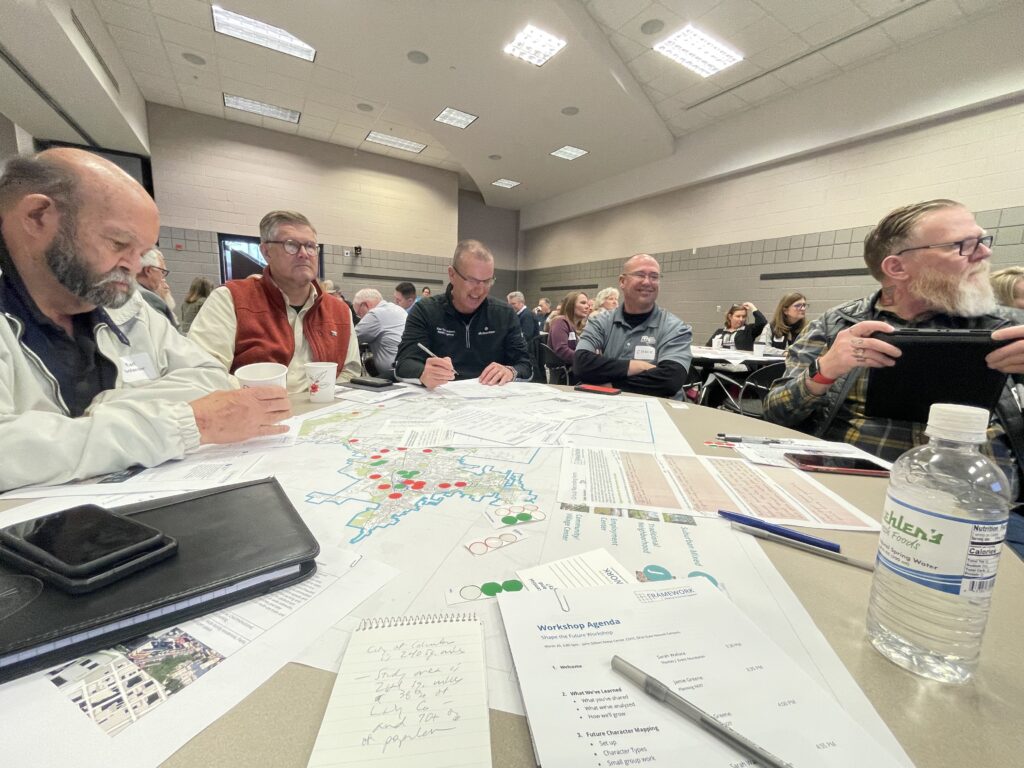
The need for county leadership in development issues also is mentioned repeatedly in the FRAMEWORK planning document, which was released in September and resulted from an unprecedented series of community forums and study funded by the Thomas J. Evans Foundation after the Intel project was announced.
State of Ohio development officials said they are “ready and willing to be a partner, but the solution must be locally driven and supported.”
“The state is awaiting a local solution for long-term planning as it relates to water sources near the Intel project,” said Mason Waldvogel, deputy chief of media relations for the Ohio Department of Development. “It’s best to speak with the communities directly involved in building and identifying infrastructure needs, as the concerns you mentioned are being addressed on the local level. The state continues to be transparent with its assistance to nearby communities. There are many partners involved in supporting this project, and we have welcomed feedback during what has been an inclusive process.”
Koehler has a different viewpoint and offered this feedback:
“For two years, this plan (to seek additional water sources for Intel) has been in place without a glimmer of communication with the communities affected. It’s unconscionable. It’s looking more like we’re on our own in this. We haven’t received a single call from the county commissioners.
“As a community, we’re unified, but we feel like we’re alone – Granville and Granville Township,” Koehler said. “We don’t think a public food fight with the state and New Albany serves any of us well, because at the end of the day, we want a soft and successful landing for Intel. Who doesn’t? But I’m catching up on two years of planning.
“This is one issue where our community is unified,” he said. “And we’ll accept no partnership in which we’re a junior partner.”
Alan Miller writes for TheReportingProject.org, the nonprofit news organization of Denison University’s Journalism program, which is funded by the Mellon Foundation and donations from readers.
Memo-Groundwater-Well-Permitting-and-Capacity-Testing-Combined-rev01-2021_10_28-1
